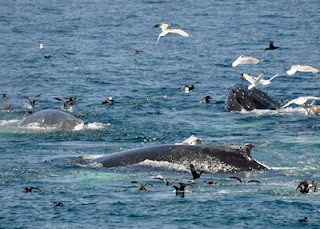June 10, 2012 Seabird & Whale Tales Excursion
8 am Seabird & Whale Tales Excursion - New England Coastal Wildlife Alliance and Krill
This past Sunday the New England Coastal Wildlife Alliance (NECWA) in collaboration with Captain John Boats conducted their all day marine wildlife cruise as a benefit for NECWA. This is an all day affair where we have 8 hours to enjoy ourselves offshore. Having a longer period of time out on the water allows us to get further offshore than we can with a standard 4-hour whale watch. And this extra time allows us to be able to stay with the animals a little bit longer.
This Sunday, we headed south to the waters off Chatham for we heard reports of a large concentration of whales and seabirds feeding to the east of Chatham. As soon as we left the dock around 8 am, we headed right for Race Point and then worked our way down the backside of the Cape. It took us almost 3 hours of steaming and over 61 miles before we found what we were looking for.
We were 26 miles east of Chatham when we saw many blows in front of us. Our captain, Capt. Tommy O'Reilly did an excellent job of getting us into this concentration of whales, seabirds and fishing boats. We must have had at least 50 to 80 humpbacks feeding at the surface, some feeding along while others were feeding in small groups of up to 8 individuals. And we had thousands of shearwaters, mainly sooty shearwaters feeding right alongside the whales.
Here is a list of the humpback whales that we have identified from this trip so far. I want to thank our NECWA staff (who are also Captain John naturalists) for their time and efforts offshore, especially helping to ID the humpbacks as we headed back to Plymouth Harbor at the end of the day.
Alphorn, Anchor and calf, Apex, Bounce, Buzzard, Canopy, Cantilever, Centipede, Compass's 2008 calf, Coral, Crown, Crystal, Entropy, Fern, Ganesh, Habenero, Hancock, Isthmus, Midnight, Milkweed, Mystery, Palette and calf, Perseid, Pharos, Pisces and calf, Pox, Putter, Rapier and calf, Release, Rune, Shards, Springboard, Strike, Stub, Tau, Touche, Tracer, Treasure and Xylem.
Alphorn, Anchor and calf, Apex, Bounce, Buzzard, Canopy, Cantilever, Centipede, Compass's 2008 calf, Coral, Crown, Crystal, Entropy, Fern, Ganesh, Habenero, Hancock, Isthmus, Midnight, Milkweed, Mystery, Palette and calf, Perseid, Pharos, Pisces and calf, Pox, Putter, Rapier and calf, Release, Rune, Shards, Springboard, Strike, Stub, Tau, Touche, Tracer, Treasure and Xylem.
Purchasing Photos on NECWA's SmugMug site
Kari Heistand, one of our NECWA staff, has posted many of her photos on the NECWA SmugMug site. You can view the photos by going to http://smu.gs/Nds4tg. Kari also posted Bill Rossiter's images of the humpback whales feeding right under the bow of the boat. All photo purchases will go directly to NECWA and will support our many projects and activities. Here is the trip report by David Clapp. A big thank you to David for writing up this report.
Whales and Birds, Oh My!!We knew early on that there were only a few whales and almost no sea birds in the Stellwagen Bank area. The NOAA crew was out on Stellwagen Friday and saw very little. So, we decided before leaving the pier that we had to run around Provincetown and down the backside of the Cape; past Truro, Wellfleet, Eastham, and Orleans. Our destination was to be a reliable, but distant, feeding area well off Chatham Light. It was about 27 miles offshore and a long boat ride from Plymouth. But, we had flat water and a lovely day to travel - so we went for it.
And are we glad we did!!
There were about eighty humpback whales in the area; 42 flukes were photographed and 37 individuals were identified. The others were too distant to bother with; there were whales everywhere. During the day a few Minke whales wandered through and there was one report of poorly and briefly seen dolphins.
The whales were bubble-feeding in groups up to six animals; as far as the eye could see. It was spectacular. The whales were one thing as they created and pierced pierced bubble nets taking sand lance by the ton. But there was more; as each net started to form, and as the bubble rose to the surface, hundreds of sooty shearwaters would flutter to the bubbles and await the frantic scurry of the small fish as the whales forced the toward the surface. They were well aware of the feeding habits of these whales and able to eat until they were to heavy to fly. There were times were the ocean was frothy with whale-blown bubbles and thousands of pencil-sized sand lance swam frenetically in all directions.
There were 3,000 or more sooty shearwaters, great shearwaters (35), Manx shearwaters (4), pomarine and parasitic jaegers (2 each), northern gannets (40ish) and a few Wilson’s Storm-Petrels and lots of hard-working gulls. There should have been hundreds of Wilson’s Storm-Petrels but for some reason there were very few. The birders also had a few common loons, terns, and cormorants. A surprise bird was seen off Race Point on the return trip. There were two Razorbills floating just off shore well seen and photographed.
It was a great day - special and memorable even for those of us who do this with some regularity.
Thanks NECWA.
David Clapp’s blog page ontheroadwithdec has three pages dedicated to this trip.
Great Shearwater 35
Manx Shearwater 4
Wilson's Storm-Petrel 30
Pomarine Jaeger 2
Parasitic Jaeger 2
Northern Gannet 40
Laughing Gull 40
Herring Gull 200
Great Black-backed Gull 40
Common Tern 65
Common Loon 8
Double-crested Cormorant 20
Razorbill 2
John McGannon has posted two You Tube videos from this all day trip. Check out the links below.




WW_SAWT_peeps_2150.jpg)





Comments
Post a Comment